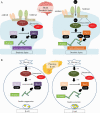Mechanisms Underlying the Comorbidity of Schizophrenia and Type 2 Diabetes Mellitus
- PMID: 33315097
- PMCID: PMC8130204
- DOI: 10.1093/ijnp/pyaa097
Mechanisms Underlying the Comorbidity of Schizophrenia and Type 2 Diabetes Mellitus
Abstract
The mortality rate of patients with schizophrenia is high, and life expectancy is shorter by 10 to 20 years. Metabolic abnormalities including type 2 diabetes mellitus (T2DM) are among the main reasons. The prevalence of T2DM in patients with schizophrenia may be epidemiologically frequent because antipsychotics induce weight gain as a side effect and the cognitive dysfunction of patients with schizophrenia relates to a disordered lifestyle, poor diet, and low socioeconomic status. Apart from these common risk factors and risk factors unique to schizophrenia, accumulating evidence suggests the existence of common susceptibility genes between schizophrenia and T2DM. Functional proteins translated from common genetic susceptibility genes are known to regulate neuronal development in the brain and insulin in the pancreas through several common cascades. In this review, we discuss common susceptibility genes, functional cascades, and the relationship between schizophrenia and T2DM. Many genetic and epidemiological studies have reliably associated the comorbidity of schizophrenia and T2DM, and it is probably safe to think that common cascades and mechanisms suspected from common genes' functions are related to the onset of both schizophrenia and T2DM. On the other hand, even when genetic analyses are performed on a relatively large number of comorbid patients, the results are sometimes inconsistent, and susceptibility genes may carry only a low or moderate risk. We anticipate future directions in this field.
Keywords: ARHGEF11; Akt/GSK3β; DISC1; Wnt/β-catenin; kalirin.
© The Author(s) 2020. Published by Oxford University Press on behalf of CINP.
Figures


Comment in
-
The Etiology of Metabolic Disturbances in Schizophrenia: Drugs, Genes, and Environment.Int J Neuropsychopharmacol. 2021 Oct 23;24(10):854-855. doi: 10.1093/ijnp/pyab047. Int J Neuropsychopharmacol. 2021. PMID: 34252192 Free PMC article. No abstract available.
References
-
- Achyut BR, Srivastava A, Bhattacharya S, Mittal B (2007) Genetic association of interleukin-1beta (-511C/T) and interleukin-1 receptor antagonist (86 bp repeat) polymorphisms with Type 2 diabetes mellitus in North Indians. Clin Chim Acta 377:163–169. - PubMed
-
- Agarwal SM, Caravaggio F, Costa-Dookhan KA, Castellani L, Kowalchuk C, Asgariroozbehani R, Graff-Guerrero A, Hahn M (2020) Brain insulin action in schizophrenia: something borrowed and something new. Neuropharmacology 163:107633. - PubMed
-
- Albayrak Y, Beyazyüz M, Beyazyüz E, Kuloğlu M (2014) Increased serum prolactin levels in drug-naive first-episode male patients with schizophrenia. Nord J Psychiatry 68:341–346. - PubMed
-
- Anderson D, Cordell HJ, Fakiola M, Francis RW, Syn G, Scaman ES, Davis E, Miles SJ, McLeay T, Jamieson SE, Blackwell JM (2015) First genome-wide association study in an Australian aboriginal population provides insights into genetic risk factors for body mass index and type 2 diabetes. PLoS One 10:e0119333. - PMC - PubMed
Publication types
MeSH terms
LinkOut - more resources
Full Text Sources
Medical

